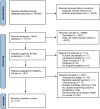Are we Using the Right Evidence to Inform Suicide Prevention in Low- and Middle-Income Countries? An Umbrella Review
- PMID: 38480516
- PMCID: PMC11809771
- DOI: 10.1080/13811118.2024.2322144
Are we Using the Right Evidence to Inform Suicide Prevention in Low- and Middle-Income Countries? An Umbrella Review
Abstract
Objective: Suicide disproportionately affects low- and middle-income countries and evidence regarding prevention approaches developed in high income countries may not be applicable in these settings. We conducted an umbrella review to assess whether the conclusions of suicide prevention systematic reviews accurately reflect the studies contained within those reviews in terms of setting generalizability.
Methods: We conducted database searches in PubMed/Medline, Embase, PsycInfo, PsychExtra, OVID global health, and LILACS/BECS. We included systematic reviews with the outcome of suicide, including bereavement studies where suicide death was also the exposure.
Results: Out of the 147 reviews assessed, we found that over 80% of systematic reviews on suicide deaths do not provide an accurate summary of review findings with relation to geographic relevance and ultimately generalizability.
Conclusion: Systematic reviews are often the resource used by practitioners and policymakers to guide services. Misleading reviews can detrimentally impact suicide prevention efforts in LMICs. We call for systematic reviewers to be responsible when generalizing the findings of their reviews particularly in the abstracts.
Keywords: Global mental health; self-harm; suicide.
Conflict of interest statement
No potential conflict of interest was reported by the author(s).
Figures
Similar articles
-
Prevention of self-harm and suicide in young people up to the age of 25 in education settings.Cochrane Database Syst Rev. 2024 Dec 20;12(12):CD013844. doi: 10.1002/14651858.CD013844.pub2. Cochrane Database Syst Rev. 2024. PMID: 39704320
-
Factors that influence participation in physical activity for people with bipolar disorder: a synthesis of qualitative evidence.Cochrane Database Syst Rev. 2024 Jun 4;6(6):CD013557. doi: 10.1002/14651858.CD013557.pub2. Cochrane Database Syst Rev. 2024. PMID: 38837220 Free PMC article. Review.
-
Falls prevention interventions for community-dwelling older adults: systematic review and meta-analysis of benefits, harms, and patient values and preferences.Syst Rev. 2024 Nov 26;13(1):289. doi: 10.1186/s13643-024-02681-3. Syst Rev. 2024. PMID: 39593159 Free PMC article.
-
Interventions to improve safe and effective medicines use by consumers: an overview of systematic reviews.Cochrane Database Syst Rev. 2014 Apr 29;2014(4):CD007768. doi: 10.1002/14651858.CD007768.pub3. Cochrane Database Syst Rev. 2014. PMID: 24777444 Free PMC article.
-
Factors that influence parents' and informal caregivers' views and practices regarding routine childhood vaccination: a qualitative evidence synthesis.Cochrane Database Syst Rev. 2021 Oct 27;10(10):CD013265. doi: 10.1002/14651858.CD013265.pub2. Cochrane Database Syst Rev. 2021. PMID: 34706066 Free PMC article.
Cited by
-
Adverse childhood experiences and suicidality in low-income and middle-income countries: a systematic review and meta-analysis.BMJ Glob Health. 2025 May 2;10(5):e018129. doi: 10.1136/bmjgh-2024-018129. BMJ Glob Health. 2025. PMID: 40316412 Free PMC article.
-
Links between climate change and suicidal behavior risks.Nat Med. 2025 May;31(5):1391-1393. doi: 10.1038/s41591-025-03528-7. Nat Med. 2025. PMID: 40155560 No abstract available.
-
Can #chatsafe support parents and carers beyond Australia? A qualitative study.BMC Public Health. 2024 Jun 11;24(1):1571. doi: 10.1186/s12889-024-19040-5. BMC Public Health. 2024. PMID: 38862974 Free PMC article.
-
Uplifting ethnic minority voices in the Western Pacific region: a priority for regional suicide research.Lancet Reg Health West Pac. 2025 Mar 31;57:101540. doi: 10.1016/j.lanwpc.2025.101540. eCollection 2025 Apr. Lancet Reg Health West Pac. 2025. PMID: 40236267 Free PMC article. No abstract available.
References
-
- Ahmed, H. U., Hossain, M. D., Aftab, A., Soron, T. R., Alam, M. T., Chowdhury, M. W. A., & Uddin, A. (2017). Suicide and depression in the World Health Organization South-East Asia Region: A systematic review. WHO South-East Asia Journal of Public Health, 6(1), 60–66. 10.4103/2224-3151.206167 - DOI - PubMed
Publication types
MeSH terms
Grants and funding
LinkOut - more resources
Full Text Sources
Miscellaneous

